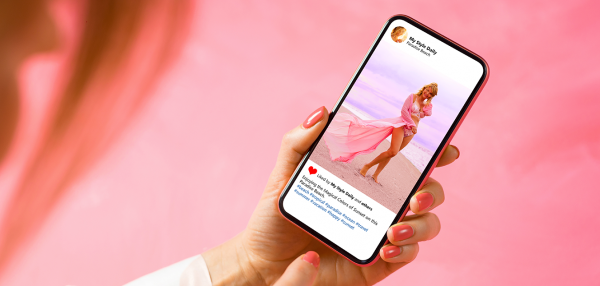Maximizing Your Paid and Organic Social Media for Black Friday
by Andrea Neipp • October 14, 2021
By Andrea Neipp , Vice President of Brand Marketing
The time is right for marketers preparing for Black Friday to take a close look at their organic and paid social media strategies. Take inventory of what went well last year and update your strategy where improvements need to be made. Far from being a sideshow, social media is a great place to bring the customer journey to fruition. As you gear up for Black Friday and the holiday shopping season, look for ways to maximize both your paid and organic social media marketing strategies.
Here are some of the best practices for both.

Organic Social Media Posts
The point of organic social media posts is to look natural and be natural. Engaging your followers and finding new ones is the purpose, but you want to avoid posts that sound mechanical or salesey. They won’t achieve the goal. Keep these best practices in mind this Black Friday:
1. Write to a Specific Person
Write for your buyer profile. If you don’t already have one, make one. Know your ideal reader and frame your post around that person’s needs and interests.
Why are they following your page? What are the exact things troubling them in their personal or professional lives right now? What are the pain points you can solve? What about your post can make their lives better or easier here and now? Tomorrow?
Don’t write for an audience, followers, or even your customers. Don’t write for an abstract group at all. Think about the one person in the crowd for whom your message is tailored, then write to them.
Bonus: If you’ve done your market research well, that one person will be many people.
2. Build Relationships
People do business with those they like and trust. It may well be that your product is externally similar to others on the market, but that’s not the end of the story. People make buying decisions based on:
- Utility: What problem does the product solve for them?
- Relationship: Who is selling the product?
Many businesses focus too much on the “what” and not enough on the “who.” Social media is ripe for developing the relationship that can exist between a business and its customer base. It’s a professional relationship, to be sure, but it is grounded in legitimate give-and-take. Though it might not look like it on the outside, each of you is solving the other’s problem.
What’s the relevance for Black Friday shopping? Organic social media posts will be your opportunity this holiday season for real customer interaction. Listen to the feedback you receive, commenting whenever it’s appropriate. Identify people who interact more frequently with your posts, and send a little extra attention their way.
It’s not just about your existing customers. Visitors to your page will also see the way your company interacts with its audience, which can powerfully influence their holiday buying decisions. Building confidence and trust is the essence of relational foundations.

3. Take Different Platforms Into Account
Social media sites are not created equal. For example, Facebook lets you shape your message toward people based on things like interests, relationship status, and other qualities of a more personal nature. That’s excellent for some companies, but others are better served on a platform like LinkedIn, geared for a more professional setting and tailored for parameters like company size, industry, or job role.
You wouldn’t use the same voice for every single audience, so don’t use the same voice on every platform. Facebook and Instagram are, as a rule, more casual platforms with different cultures than LinkedIn. An organic post that works on one site might not be appropriate for the other.
4. Value Over Sales Pitches
Just because the pressure of selling merchandise is off doesn’t mean the pressure is off. Your organic social media has a definitive purpose: Selling value. Every communication you send out — even replies to customer comments — is a persuasive message in disguise, one in which value is the thing being sold.
What is value? It’s anything that persuades your customers that their time is valuably spent engaging with your brand. Even when they’re not buying something, they’re getting something. Useful information, a daily insight, and education in the forms of reports, ebooks, or PDFs are all things that contribute something of value to their daily lives, for which they’ll remember you.
For you, the value is in becoming an authority in your field — one to which your customers will turn when the time is right.

Paid Social Media Ads
Make your advertising budget count this holiday season. Instead of boosting one organic blog post to your followers, use paid ads to stretch your arms out and attract new customers across multiple social media channels. Paid ads are your opportunity to:
- Generate leads
- Convert new customers
- Grow your brand’s reputation
- Test new promotions
1. Targeting, Targeting, Targeting
What’s the best way to attract new customers for Black Friday? Find people who have interests similar to your product and make them an offer. Whenever you’re running a discount or promotion, paying to advertise it across the platform ensures that it reaches more than the people who already follow you. Direct your organic posts toward those potential customers, and don’t hesitate to get a little creative for paid social media ads.
When you set the parameters of the ad, customize it so that it flows through your network of followers and out toward people who follow similar accounts and topics. Even though they’re not following you, you already know they’re broadly interested in your product. It makes them the perfect choice for a nearly irresistible perk — like a 50% off discount.
2. Retargeting, Retargeting, Retargeting
Consistency is the key. Remember that HubSpot research has found that it takes as many as 8 touches before a person is ready to buy from you. You already know going into the holiday that, even with an interested prospect, you’ll need to make multiple contacts to secure a sale. Prepare your retargeting infrastructure well in advance of Black Friday to make sure that happens.
Always send out paid ads with embedded tracking pixels. You’ll need those pixels to find out who actually landed on your website and from where. The pixels will generate hits on your analytics dashboard, informing you that the website visitor clicked on a link seen on Twitter, for example — priceless information for marketers.
Not using pixels would be like flying blind. With them, you can retarget customers who’ve already shown interest across multiple social media platforms and websites, multiplying the number of touches they receive from you until they’re ready to make the purchase.
3. Test to Find Out What Social Media Platform to Use
The social media platform where you have the most followers isn’t always the most effective platform for paid ads. There’s no real reason to spend money on followers you’ve already attracted. Your time might be better served engaging your followers and reaching new ones through organic marketing methods on that platform.
You need to do testing to know for sure if your methods are working. It’s the most important tool in the advertiser’s toolbox. To find out which platform is best for your paid ads, send out limited ad campaigns to the most promising ones — and even a few not-so-promising ones — and measure the results.
4. Be Concise and Clear About What You Want
What’s the best way to persuade people to do what you’d like them to do? Just ask. In concrete marketing terms, that means you state clearly in writing what your reader should do to find more information and how they should do it. Always end with a direct call to action and a hyperlink that tells them to “Buy now” or “Call us today.”
The idea is to remove as many obstacles and excuses standing between your customer and your bottom line. Look, you paid to put this ad out there, didn’t you? Black Friday competition is no friend to sloppy marketers. Don’t fumble through unclear wording or leave your readers unsure about how they should proceed. If there’s any such hassle, they’ll take their holiday shopping elsewhere.

Move Toward an Integrated and Hybrid Strategy
Paid advertising isn’t always the answer. Many companies have great success with organic social media, where the lucky “viral” post that costs next to nothing can yield more profit than any of your paid ads. Nonetheless, there are a few key indicators to tell you when it’s time to use a paid ad:
- Upon announcing anything new, be it a discount, product, or anything else deserving of broadcast.
- Did a recent organic post create a lot of buzz? That’s a sign to boost the post and get more eyes on it.
Brick-and-mortar storefronts have both salespeople and customer service people. Meeting, greeting, and educating a customer is a different skill set than persuading them to buy something. It is, however, a related skillset; all storefronts, online or offline, will be needing a healthy serving of both to prosper this holiday season.
That same principle holds for your website and social media pages. While organic marketing and paid advertising operate at different levels, excellent strategists looking ahead to Black Friday 2021 will be working to fuse them together into sweet harmony.
Next week, our VP of Creative and Design, Sarah Rodriguez will be sharing tactical tips for creating successful ads and content for social media.




